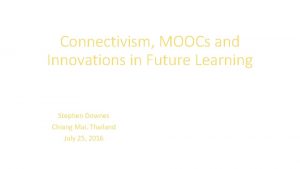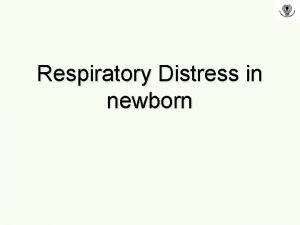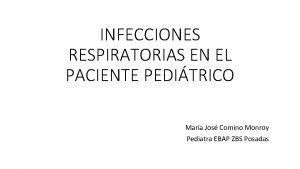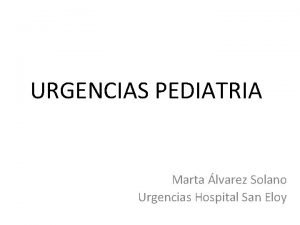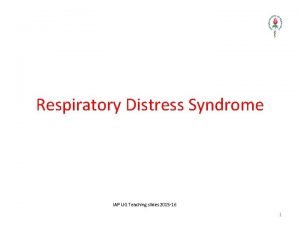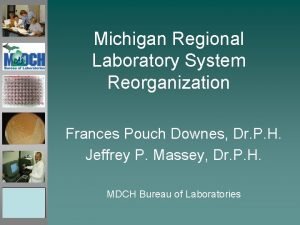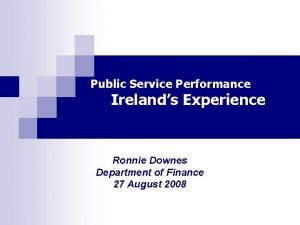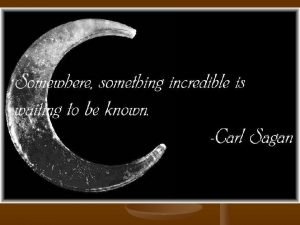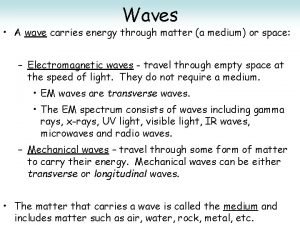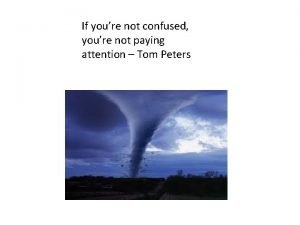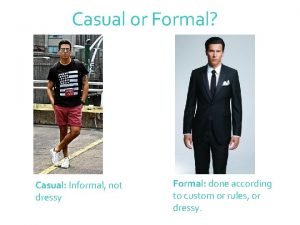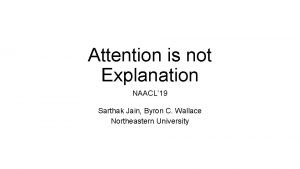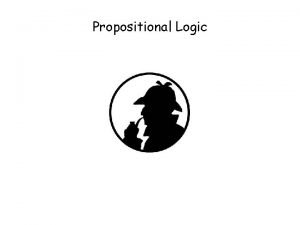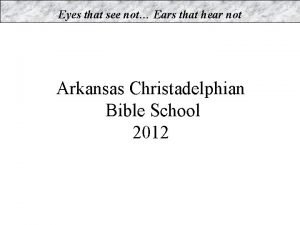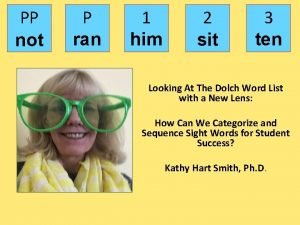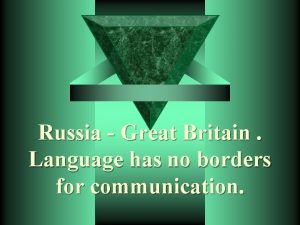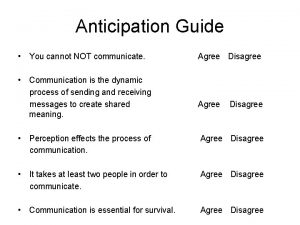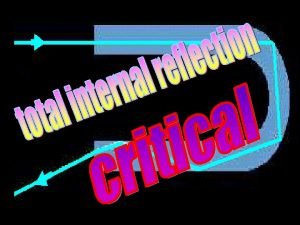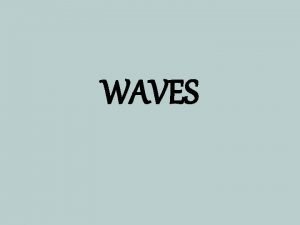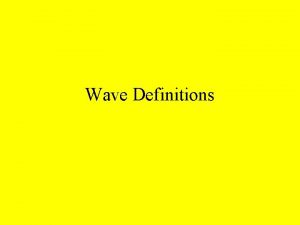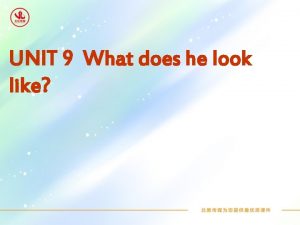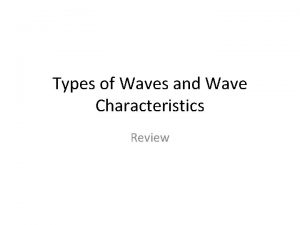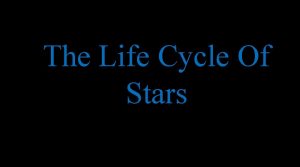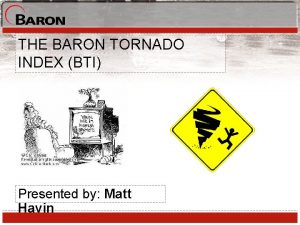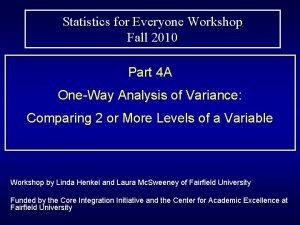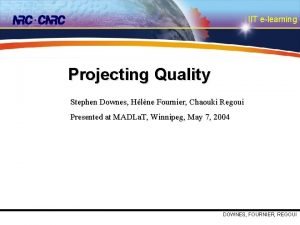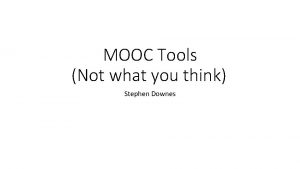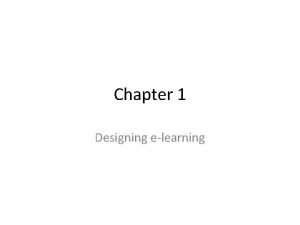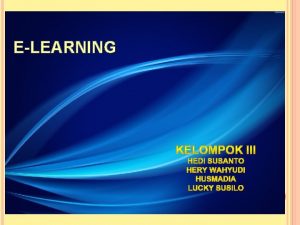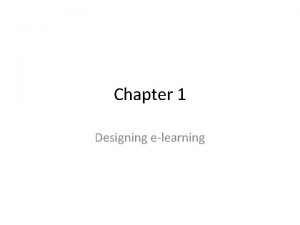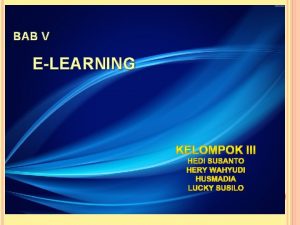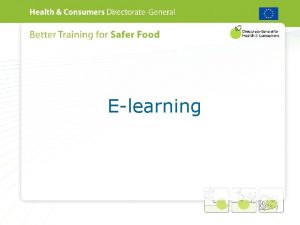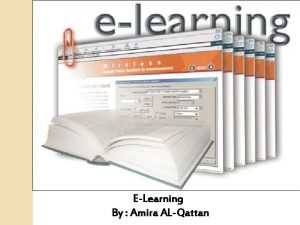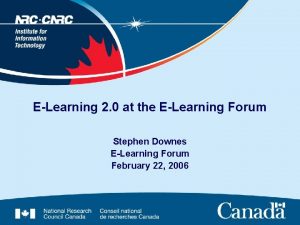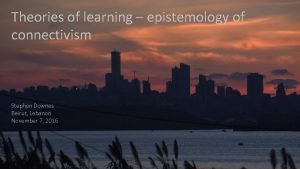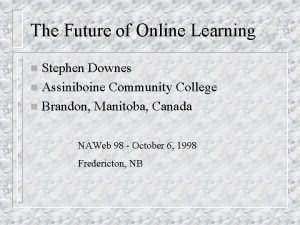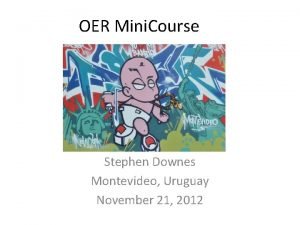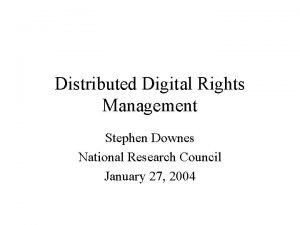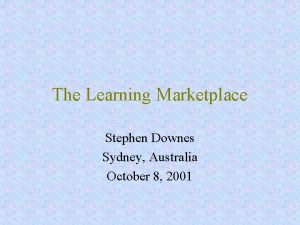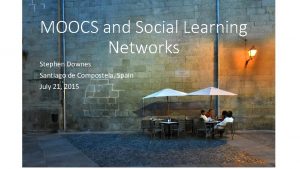ELearning 2 0 Platform Not Medium Stephen Downes










































- Slides: 42

E-Learning 2. 0 – Platform, Not Medium Stephen Downes National Research Council Canada June 9, 2006

1. The Network

Two Models of Online Environments • Centralized • Distributed

Centralized Environments • Before the web, the centralized model was all we had (examples include Compu. Serve, Prodigy) • On the web, centralized models include site-based services such as Yahoo! • Most (all? ) college and university services are offered using the centralized model • But centralized environments are static, inflexible, expensive

Distributed Environments • The World Wide Web is an example of a distributed environment • Resources, access are not centralized, but scattered around the world: – Resources, in the form of a network of connected (via DNS) web servers – Access, in the form of a network of connected (via DNS) internet service providers – Users, in the form of individualized and connected (via HTTP) web browsers • The big issue – integration – that is, making different systems work together

Integration • Many ways to do integration – some are more centralized than others • Scott Wilson – Service Oriented Frameworks for E-Learning http: //standards. edna. edu. au/idea/summer 2005/ppt/OTF 20050209_scottwilson. ppt • Two views of integration: http: //www. cetis. ac. uk/content 2/20050124115817 – Service Oriented – ie. , commonly defined services – use APIs (Application Program Interfaces) – Client Oriented – ie. , distributed applications – use client applications (eg. Plugins) • Gets complex in a hurry – which is why so many prefer the control of a centralized approach

Sensible Design Principles • The analysis of customer needs has to concentrate on practical uses that are likely to become everyday routines • The development of a new technology must be based on well–defined, carefully selected core principles • Real experiences in real networks must be continuously taken into account. http: //www. firstmonday. org/issues/issue 10_1/kilkki/ • Or, as the author concludes: "As to the list of core principles, simplicity and realism are essential. "

2. Design Principles

Network Design Principles – Specifies how networks differ from traditional learning – The idea is that each principle confers an advantage over non-network systems – Can be used as a means of evaluating new technology

1. Decentralize – Centralized networks have a characteristic ‘star’ shape • Some entities have many connections • The vast majority have few • Eg. , broadcast network, teacher in a classroom – Decentralized networks form a mesh • The weight of connections, flow is distributed • Balanced load = more stable • Foster connections between entities, ‘fill out’ the star

2. Distribute – Network entities reside in different physical locations • Reduces risk of network failure • Reduces need for major infrastructure, such as powerful servers, large bandwidth, massive storage – Examples: • Peer-to-peer networks, such as Kazaa, Gnutella • Content syndication networks, such as RSS – Emphasis is on sharing, not copying • ‘Local’ copies are temporary

3. Disintermediate – Mediation – barrier between source and receiver – Examples: • Editors, peer review prior to publication • Traditional media, broadcasters • Teachers between knowledge and student – Where possible, provide direct access • The purpose of mediation is to manage flow, not information • It is to reduce the volume of information, not the type of information

4. Disaggregate – Units of content should be as small as possible • Content should not be ‘bundled’ • Organization, structure created by receiver • Allows integration of new information with old – This is the idea behind learning objects • smallest possible unit of instruction • Assembling into pre-packaged ‘courses’ defeats this

5. Dis-integrate – Entities in a network are not ‘components’ of one another • Thus. , eg. Plug-ins or required software to be avoided – The structure of the message is logically distinct from the type of entity sending or receiving it • The message is coded in a common ‘language’ • This code is open, not proprietary • No particular software or device is needed to receive the code – This is the idea of standards, but: • Standards are not created, they evolve • Standards adopted by agreement, not requirement

6. Democratize – Entities in a network are autonomous • Have the freedom to negotiate connections • Have the freedom to send, receive information – Diversity is an asset • Diversity confers flexibility, adaptation • Diversity enables the network as a whole to represent more than just the part – Control is Impossible • Even where control seems desirable, it is not practical • Creating control effectively destroys the network

7. Dynamize – A network is a fluid, changing entity • Without change, growth, adaptation are not possible • It is through the process of change that new knowledge is discovered – The creation of connections is a core function

8. Desegregate – Example: Learning is not a Separate Domain • Do not need learning-specific tools, processes • Learning is a part of living, of work, of play • The same tools we use to perform day-to-day activities are the tools we use to learn – The Network as Infrastructure • Computing, communicating, not something we ‘go some place to do’ • The idea of network resources as a utility, like electricity, like water, like telephones – the network is everwhere

3. The Tools

The Net Generation creates its own media… Identity Production in a Networked Culture: Why Youth Heart My. Space … Danah Boyd http: //www. danah. org/papers/AAAS 2006. html “The dynamics of identity production play out visibly on My. Space. Profiles are digital bodies, public displays of identity where people can explore impression management. ”

Blogs and Wikis "Never have so many people written so much to be read by so few. . . " -- Katie Hafner NY Times. Blogger - Live Journal - Movable Type - Wordpress Educational Blogging – article Educational Weblogs - Edublogs. org Wikipedia – as compared to Britannica by Nature

Photos, Podcasting and Vodcasting Flickr Podcasting - wikipedia i. Podder - Odeo – Liberated Syndication Youtube - video Podcasting in Learning Ed Tech Talk - Ed Tech Posse - FLOSSE Posse Bob Sprankle - Education Podcast Network

From LMS to PLE “Personal Learning Environments are systems that help learners take control of and manage their own learning. This includes providing support for learners to: * set their own learning goals * manage their learning; managing both content and process * communicate with others in the process of learning and thereby achieve learning goals. ” From JITT. http: //octette. cs. man. ac. uk/jitt/index. php/Personal_Learning_Environments

The Classic Diagram… Scott Wilson. http: //octette. cs. man. ac. uk/jitt/images/b/ba/Wilson_future_PLE. jpg

My Own Approach (1): My. Glu http: //www. downes. ca/mygluframe. htm

My Own Approach (2): RSS Writr http: //www. downes. ca/editor/writr. htm

E-Learning 2. 0 “The model of e-learning as being a type of content, produced by publishers, organized and structured into courses, and consumed by students, is turned on its head. Insofar as there is content, it is used rather than read— and is, in any case, more likely to be produced by students than courseware authors. And insofar as there is structure, it is more likely to resemble a language or a conversation rather than a book or a manual. ” Stephen Downes http: //elearnmag. org/subpage. cfm? section=articles&article=29 -1

Some Advantages of PLEs Persistence “The reflective posting of a blog are a digital record of the learning process. They can be an integral part of the lifelong learning accomplishment and eportfolio of the learner. They should not disappear at the end of a course. ” Terry Anderson http: //terrya. edublogs. org/2006/01/09/plesversus-lms-are-ples-ready-for-prime-time/

Some Advantages of PLEs (cont)… Identity “Learners have existences beyond formal school, that can be used to both help learners contextualize their own understanding and for others to understand their epistemological legacy. The PLE tools integrate this outside life with formal study. ” Terry Anderson http: //terrya. edublogs. org/2006/01/09/plesversus-lms-are-ples-ready-for-prime-time/

My Own Approach (3): m. IDm License plates Telephone ATM http: //www. downes. ca/midm. htm

Some Advantages of PLEs (cont)… “Copyright and re-use: Contributions to a PLE are very definitely owned by the learner and thus can be used and re-used as that owner sees fit. ” - Terry Anderson. More and more, we will see students – and not instructors or publishers – authoring learning resources.

My Own Approach (3): DDRM http: //www. downes. ca/dwiki/? id=DDRM

Whence the PLE? “Why do we need a PLE when we already have the Internet? The Internet is my PLE, e. Portfolio, VLE what ever. Thanks to blogger, bloglines, flickr, delicious, wikispaces, ourmedia, creative commons, and what ever comes next in this new Internet age, I have a strong online ID and very extensive and personalised learning environment. " Leigh Blackall http: //teachandlearnonline. blogspot. com/2005/11/die-lms-die-you-too-ple. html

The PLE: An approach, not an application Watch for the evolution of read/write applications Similar to Web 2. 0 ™ applications Similar also to Windows Vista The students’ application need not be a learning application Eg. More like an email client than a learning client

Attending to the ‘Read’ Part… Resource Profiles http: //www. downes. ca/files/resource_profiles. htm 1 st Party Metadataa: Bibliographical 2 nd Party Metadata: Usage 3 rd Party Metadata: Commentary Also: microformats http: //microformats. org/

The Semantic Social Network Learning = Participation in a Community The Learning Environment is the work environment (or the community environment) Resource production, selection and referral via more experienced members of the community ‘Schoolwork’ = Work in real life Stephen Downes: http: //www. downes. ca/cgi-bin/page. cgi? post=46

4. Semantics

Network Semantics – How Meaning is Created in Networks – Tells us how people learn using networks – Tells us how networks create new knowledge

Elements of Network Semantics – Context • Localization of entities in a network • Each context is unique – entities see the network differently, experience the world differently • Context is required in order to interpret signals – Salience • The relevance or importance of a message = the similarity between one pattern of connectivity and another • Meaning is created from context and messages via salience • In other words: knowledge is shared understanding (and not copied understanding)

Elements of Network Semantics (2) – Emergence • • The development of patterns in the network A process of resonance, synchronicity, not creation Example: commonalities in patterns of perception Requires an interpretation to be recognized – Memory • Persistence of patterns of connectivity – Other elements: stability, weighting…

Connectivism: Network Pedagogy – Think of as ‘Network Pragmatics’ – Deals with how to use networks to support learning – Embraces the idea of ‘distributed knowledge’ • Example: knowing how to build a 747 • ‘I store my knowledge in my friends’ • Recognizes explicity that we ‘know’ is embedded in our network of connections to each other, to resources, to the world – George Siemens http: //www. elearnspace. org/Articles/connectivism. htm

Principles of Connectivism – Learning is a process of connecting entities – Nurturing and maintaining connections is needed to facilitate continual learning. – Ability to see connections between fields, ideas, and concepts is a core skill. – Capacity to know more is more critical than what is currently known – Decision-making is itself a learning process

http: //www. downes. ca
 Stephen downes connectivism
Stephen downes connectivism Future learning mooc
Future learning mooc Silver anderson score
Silver anderson score Score de downes
Score de downes Score pulmonar asma
Score pulmonar asma Iap teaching slides
Iap teaching slides Frances downes
Frances downes Ronnie downes
Ronnie downes Hot cold media
Hot cold media Medium medium 35m newton
Medium medium 35m newton Elearning platform open source
Elearning platform open source Sadlier vocabulary workshop level d unit 1
Sadlier vocabulary workshop level d unit 1 Example of mechanical wave
Example of mechanical wave Waves that transmit energy through matter or empty space
Waves that transmit energy through matter or empty space If you're not confused you're not paying attention
If you're not confused you're not paying attention Formal casual attire
Formal casual attire Attention is not explanation
Attention is not explanation Too broad too narrow
Too broad too narrow If not p then not q
If not p then not q Not too big not too small just right
Not too big not too small just right Love is not all
Love is not all Eyes that see and ears that hear
Eyes that see and ears that hear P no l l no l om p pp
P no l l no l om p pp If you can't measure it it doesn't exist
If you can't measure it it doesn't exist We will not be shaken we will not be moved
We will not be shaken we will not be moved Not a rustling leaf, not a bird in flight
Not a rustling leaf, not a bird in flight You cannot not communicate
You cannot not communicate Wire mesh security fence
Wire mesh security fence When light travels from an optically denser medium
When light travels from an optically denser medium Medium waves
Medium waves Define interference
Define interference Stool dr test
Stool dr test Tcbs medium
Tcbs medium Medium height
Medium height Medium build
Medium build Sound waves from a radio generally travel in which medium?
Sound waves from a radio generally travel in which medium? Star with small and medium mass
Star with small and medium mass What is a tornado index
What is a tornado index Effect size f small, medium large
Effect size f small, medium large What does effect size measure
What does effect size measure Library.thinkquest.org 19537
Library.thinkquest.org 19537 Snehalaya english medium school ahmednagar
Snehalaya english medium school ahmednagar Medium term national development plan
Medium term national development plan

